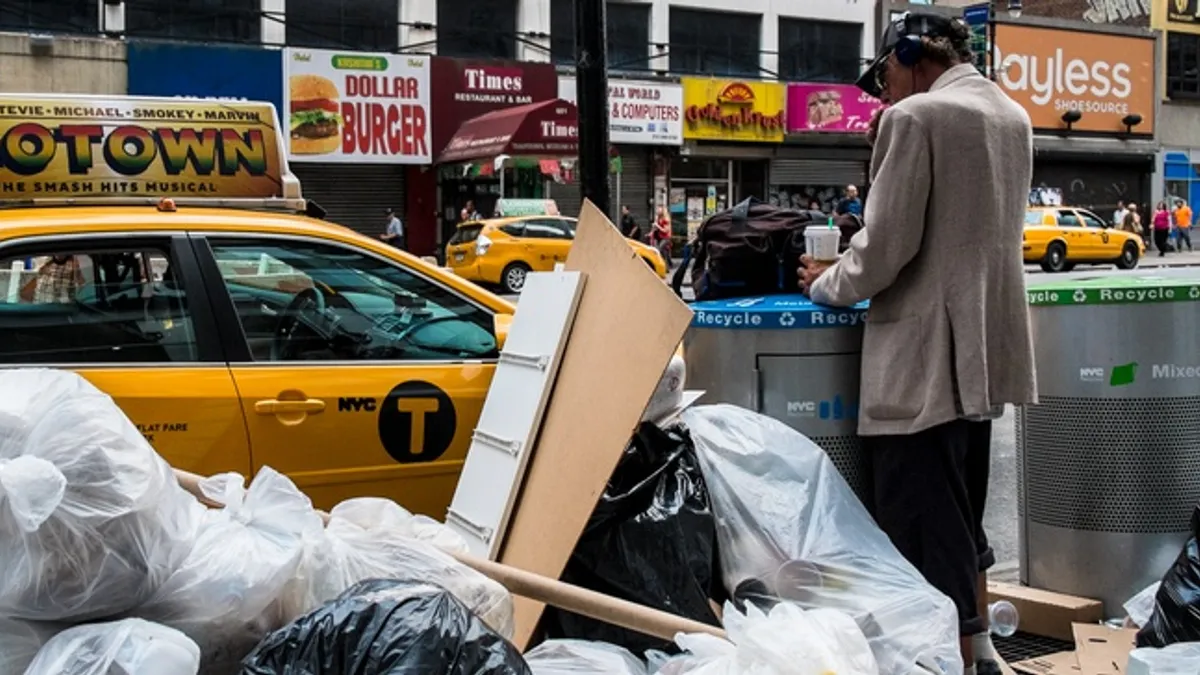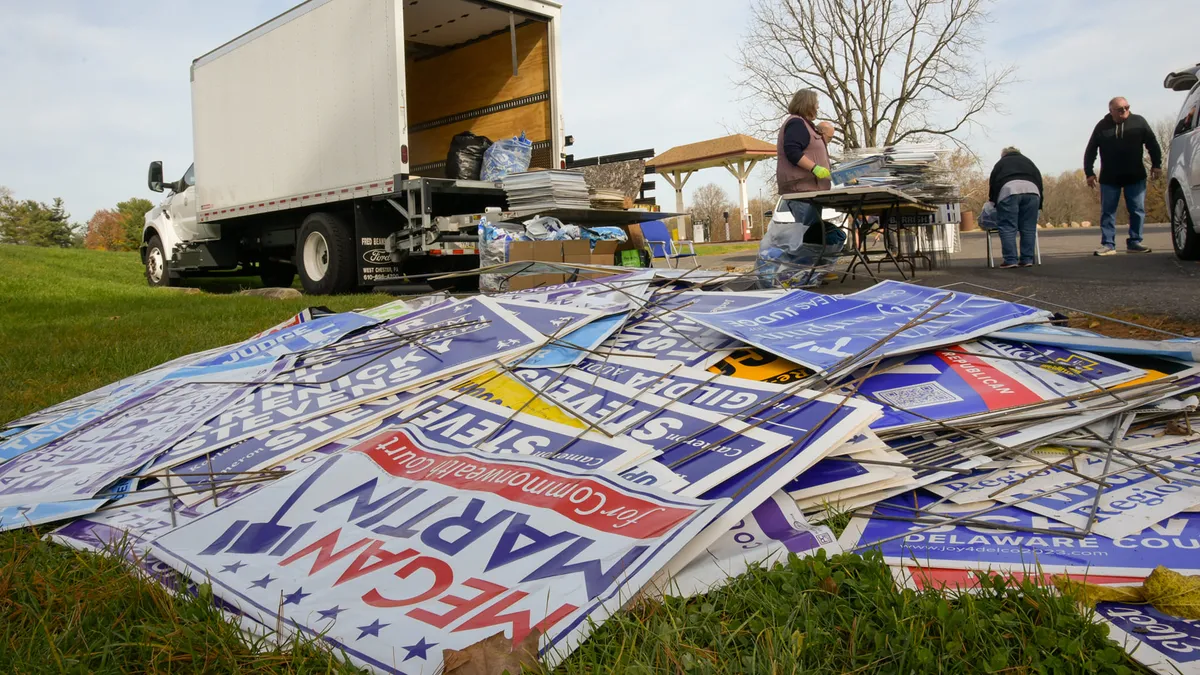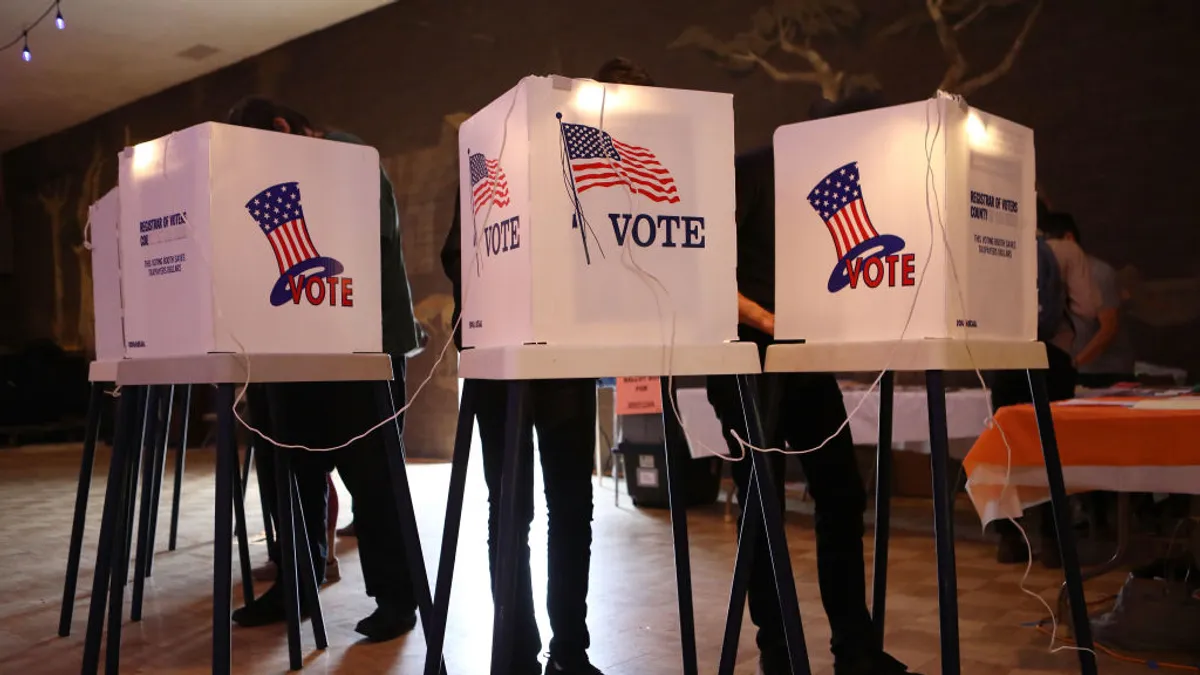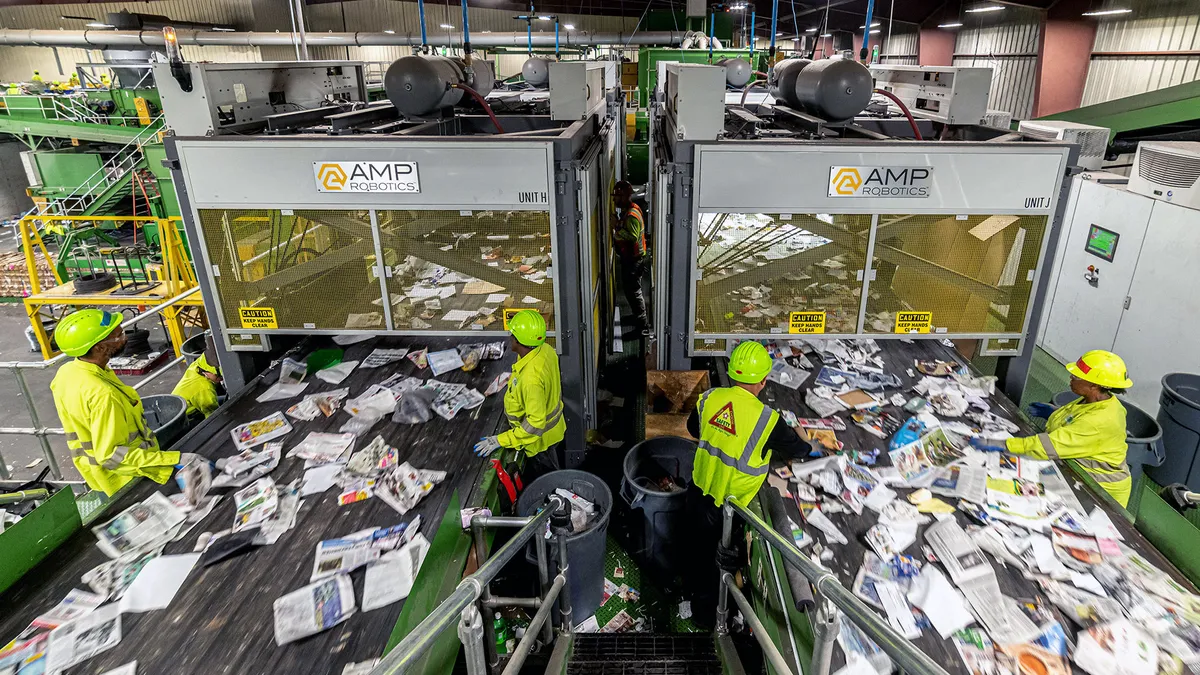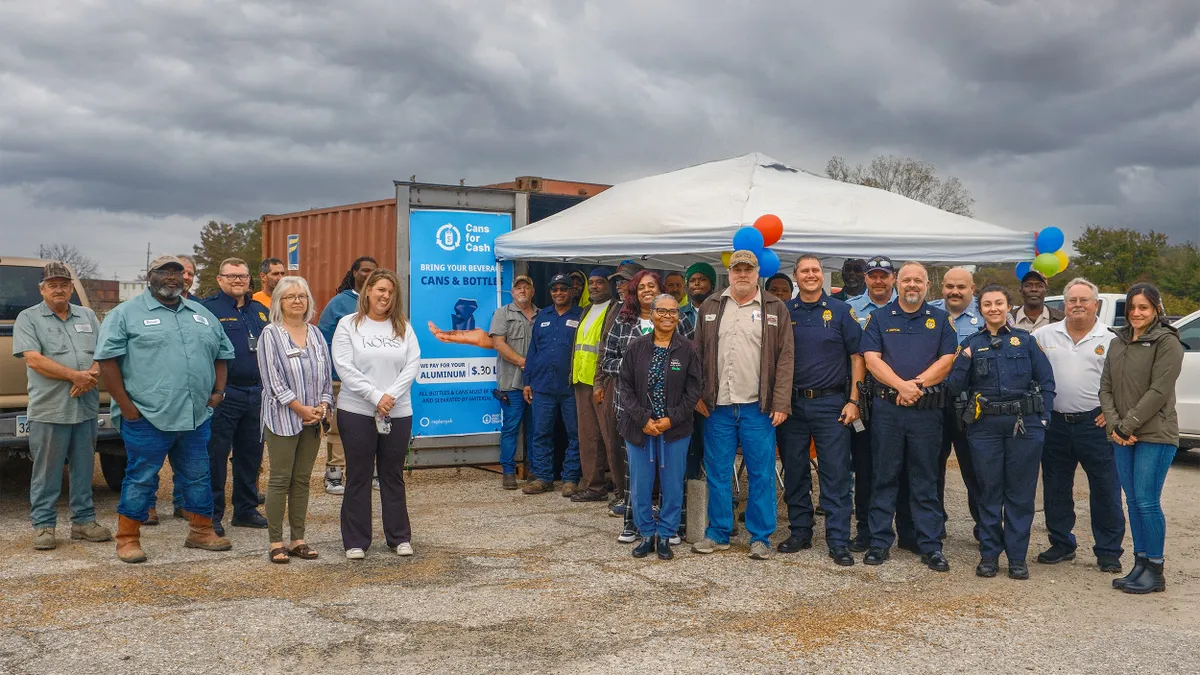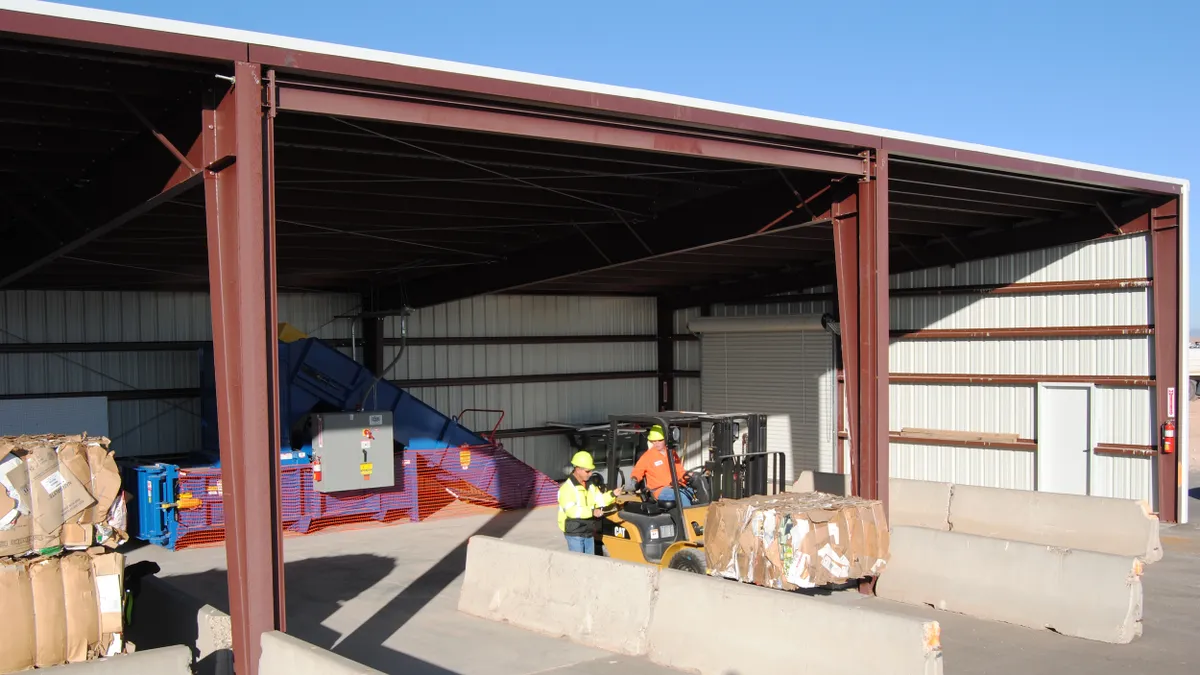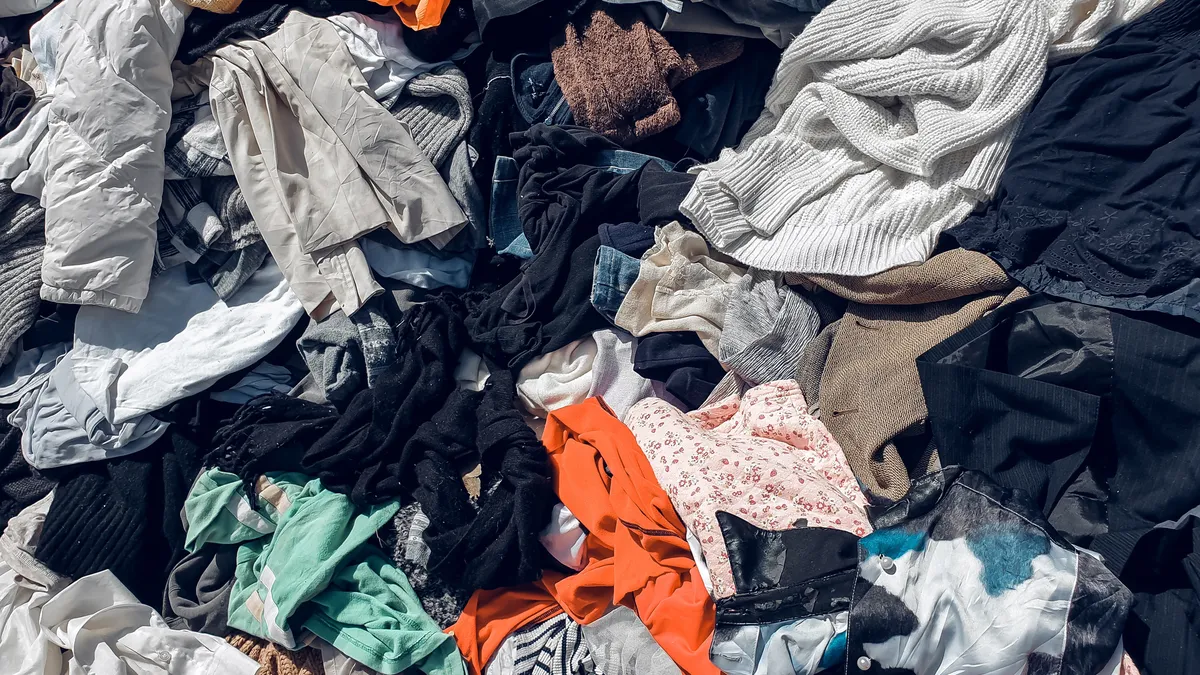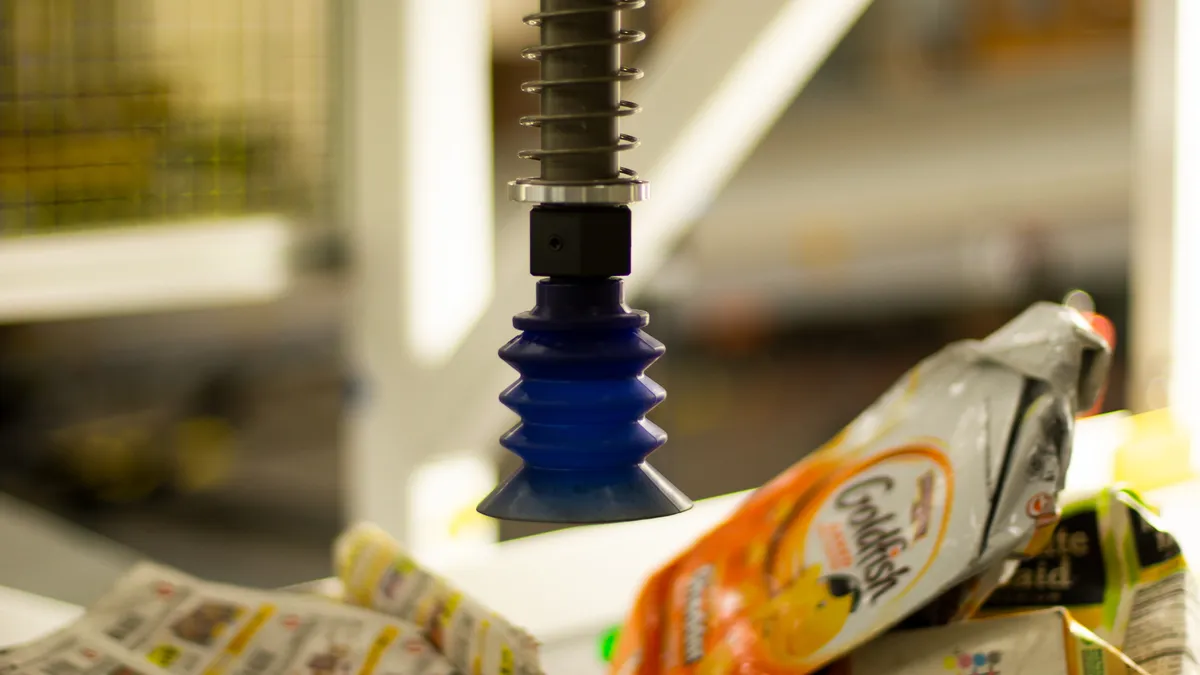Editor's Note: This piece was written by Jacquelyn Ottman, a New York-based author, zero waste advocate and founder of WeHateToWaste.com. The opinions represented in this piece are independent of Waste Dive's views.
Since 2011, the New York Department of Sanitation (DSNY) has been rolling out three voluntary programs designed to make it easy for New Yorkers to collect and sort organics, electronic waste, and textiles right inside their buildings.
Representing a key component of New York City’s Zero Waste by 2030 plan, these programs complement mandatory in-building collection for mixed recyclables (blue bins) and paper and cardboard (green bins). New York City residents only recycle 17% of their waste — half the national average — and these programs help to ensure that more of the 74% of the city’s waste stream that is recyclable actually finds its way to a facility.
As of November 2016, 154,000 households within multi-family buildings are receiving convenient clothing and textile pickups, 270,000 households are taking advantage of organics pickups and 798,000 households get their laptops, cell phones and other electronic waste picked up. More are expected over time given the city’s goal of bringing convenient collection of these highly recyclable materials to all New Yorkers via in-building pickups or neighborhood programs within walking distance.
Although these programs make recycling collection a snap for residents, they may not be so easy for building managers to implement. Getting bins placed inside buildings and enlisting resident participation requires cooperation and commitment from busy superintendents, landlords or co-op and condo boards, as well as property managers who likely have higher priorities than recycling. Indeed, many may still struggle to align residents with the mandatory blue and green collection system.
Enlisting recycling involvement "require[s] cooperation and commitment from busy superintendents, landlords or co-op and condo boards, as well as property managers who likely have higher priorities than recycling."

Jacquelyn Ottman
Founder, WeHateToWaste.com
My own building on Manhattan's Upper East Side has signed on to two out of three of these programs — our co-op board won’t allow in-house collection of organics for fear of pests. We now collect clothing and textiles with the help of a ‘re-fashioNYC’ bin in our basement alley, and residents can drop off their recyclable electronics into a large locked metal cage stored in our indoor parking garage. We have a very environmentally aware and energetic super and residents who seem to want to do their bit. But as I discovered when dropping in on some other buildings in my neighborhood, and corroborating with trash-aware colleagues around the city via a brief online survey, a full range of challenges surfaced.
The following provides some insight into what’s necessary to make these programs work, and what committed residents can do to help them gain traction among building managers and neighbors.
3 in-building recycling collection programs: an overview
Organics collection: New York City’s collection program for food scraps, yard waste and food-soiled paper now spans all five boroughs, and includes single-family homes as well as high rises. Organics are picked up by DSNY trucks once or twice per week depending on the neighborhood. Eligible households receive a starter kit that includes an indoor kitchen container, instructions, and either their own outdoor brown bin or a larger one to share (small apartment buildings) which is specially designed to limit infestation and curb odors. Residential buildings across the five boroughs with 10 or more units can apply for and enroll in organics collection service.
re-fashionNYC: This program represents a partnership between DSNY and Housing Works, a popular not-for-profit that benefits AIDS patients and combats homelessness. Free donation bins (eight square feet in size), complete with tax receipts, are available for buildings with 10 or more units. Housing Works arranges for pick-ups when the bins are reported as full.
e-cycleNYC: As of January 2015, it is illegal to put TVs, computers and other electronic waste in curbside trash. DSNY partners with ERI, an e-scrap processing firm that provides secure storage bins (or buildings can use their own) and arranges for pick-ups in apartment buildings with 10 plus units.
Challenges of in-building recycling programs
Limited space: Buildings looking to take advantage of these programs must find adequate space, ideally located near existing blue and green recycling bins and those for regular trash. Popular spots seem to be basements, and laundry rooms, but not all buildings are blessed with these extra spaces. Moreover, success brings its own challenges, since whatever extra space exists is often taken up by the storage of bulky mixed plastic, glass, metal and paper recyclables, which are picked up just once weekly (compared to twice or thrice weekly trash pickups.)
Getting commitment from boards, property managers and supers: Superintendents seem to be the gatekeeper for these voluntary programs since they are responsible for trash management and building maintenance. Skepticism is an issue, and these building officials tend to ask questions: Will residents actually participate in these programs, or will they represent additional work with the possibility of no results? What if the clothing, electronics and especially organics are not collected as promised, within five to seven business days? Not surprisingly, collection of organics raises particular concerns about smell, and food scraps becoming a magnet for flies or rodents.
Challenges among residents: Enthusiasm for and alignment with existing blue and green bin recycling collection programs can be a gauge of potential receptivity for these new voluntary programs. Co-locating bins in well-trafficked spaces helps create awareness, but time and resources still need to be allotted to provide specifics on what to drop in the bins and what to direct to the trash, all to minimize "aspirational recycling." Time can also be consumed in picking up after residents who drop non-recyclables into the bins.
Strategies for success
With so many potential barriers, it's critical to demonstrate how these programs actually enhance building operations, and how easy they are for residents to comply with.
1. Underscore the benefits supers and higher level managers want to hear: these voluntary collection programs can ultimately save staff time, effort and money. According to Catherine Bragdon of NYC’s Department of Health and Mental Hygiene, initial testing found that buildings using the hard plastic, securely sealed organics bins experienced no more rodents than in buildings that stored food-laden trash in traditional thick-ply black trash bags which can tear and leak.
2. Underscore the credibility of DSNY’s partners, Housing Works and ERI, whose goal is to make sure pick-ups happen as promised within five to seven business days. Remind management that these programs help to educate residents about recycling and establish new waste habits. What can be especially helpful is to find other building supers who are willing to share their experiences and strategies for success.
3. Help co-op and condo boards appreciate how successful implementation can improve building aesthetics, help manage trash costs and attract new residents. When presenting to a co-op or condo board, attempt to enlist a like-minded champion member. Emphasize potential savings in staff time that can be put to better use on building upkeep. Remind board members that these programs could eventually become mandatory, indicating that effort spent now can save on fines later. Offer the names of other residents who are also in support. Finally, report on positive results in other buildings (or seek the help of DSNY reps to do so).
4. Reinforce the strategic business opportunity for property managers’ own organizations: these programs can help them develop new expertise that can lead to better management of buildings across their entire portfolio, and give their firm a competitive advantage in attracting new clients.
How to educate residents
Chances are, resident interest in program participation will vary from apathetic to enthusiastic. Start by focusing on like-minded neighbors who may especially appreciate the environmental and convenience benefits, then entice others with financial benefits associated with containing costs. Also be sure to point residents to bin locations with DSNY-supplied posters, flyers and signs that can be customized to let residents know about the programs.
In the meantime, organics, clothing and e-waste are also being collected at greenmarkets run by GrowNYC in the five boroughs, and at various pop-up events around the city. Residents whose buildings are not participating in these new collection programs for whatever reason can take their recyclable organics, clothing and e-waste to neighborhood collection facilities.
NYC, with its 8.5 million residents speaking 35 languages and creating 12,000 tons of residential waste per day (half the city’s total), has unique and pressing challenges. It will only be with the commitment of all parties that these new programs will be successful. Empowered residents have an important role to play.


